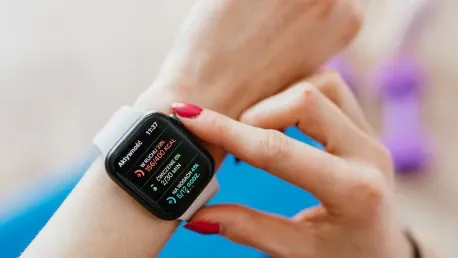As healthcare technology advances, the integration of wearable devices with custom healthcare solutions prompts us to reconsider our traditional approach to health and wellness. Wearables have the potential to significantly enhance personalization, improve patient outcomes, and shift the focus towards preventative care. However, this integration brings notable challenges that require careful attention and resolution. From fitness trackers to advanced health monitors, wearable technology is becoming an integral part of health monitoring and management. As these devices evolve, they offer users the ability to track various health metrics, providing valuable data that can be used to create personalized treatment plans. This innovation has the potential to transform healthcare by making it more tailored to individual needs and circumstances.
Market Growth and Industry Expansion
The wearable healthcare device market is experiencing rapid growth. Previously viewed as novelties, these devices are now considered essential tools for health monitoring. According to industry reports, the wearable healthcare device market is positioned to reach billions in valuation within the next decade. This is driven by increased health awareness, technological advances, and a global shift toward preventative healthcare. Major players like Fitbit, Garmin, and Apple are at the forefront, offering a wide range of devices from basic fitness trackers to advanced health monitors that track heart rate variability and other important metrics.
In addition to general health wearables, specialized medical wearables are also emerging. Continuous glucose monitors for diabetic patients and wearable ECG devices for cardiac monitoring are just a few examples of how wearable technology is branching out into more specific areas of healthcare. The COVID-19 pandemic significantly accelerated the adoption of these technologies. As hospitals became overwhelmed and patients found it difficult to visit clinics, wearables proved essential for remote health monitoring. This established their critical role in the future landscape of healthcare systems and highlighted their potential for wider applications.
Benefits of Integration: Personalization and Proactivity
One of the most compelling advantages of integrating wearable technology with custom healthcare solutions lies in the high degree of personalization it offers. Wearable devices are capable of collecting real-time, user-specific data, which healthcare providers can utilize to craft bespoke treatment plans. This personalized approach not only improves patient outcomes but also empowers users by making them active participants in their own healthcare management. By involving patients in their treatment plans, wearables foster a sense of ownership and accountability that can lead to better adherence and results.
Another notable benefit of wearable devices is their utility in postoperative care. They can continuously monitor vital signs and send automatic alerts to healthcare providers if any abnormalities are detected. This allows for timely interventions, reducing the risk of complications and improving recovery times. Traditional healthcare models rely on periodic visits and static patient information, but wearable technology enables a more dynamic and comprehensive view of patient health. This real-time functionality allows for proactive care and issue resolution before severe complications arise, potentially saving lives and reducing healthcare costs.
Wearable devices also play a crucial role in preventative healthcare by monitoring factors such as sleep patterns, activity levels, and stress. This data can prompt users to make lifestyle adjustments that mitigate the risk of developing chronic conditions like obesity and cardiovascular disease. For example, a fitness tracker might encourage a user to take a walk after a prolonged period of inactivity, promoting physical activity and better overall health. By providing actionable insights into daily habits, wearables can lead to more informed decisions and healthier lifestyles.
Challenges and Solutions
Despite the numerous benefits of integrating wearable technology with healthcare solutions, several significant challenges must be addressed. One of the primary concerns is data security. Wearable devices generate vast amounts of sensitive health data, necessitating substantial investment in robust cybersecurity measures to ensure data protection. Without adequate security protocols, the risk of data breaches and unauthorized access to personal health information remains a serious issue that could undermine public trust in these technologies.
Accuracy is another critical concern. Not all wearables meet the stringent reliability standards required for medical applications. Inaccurate data readings can lead to inappropriate treatments, potentially endangering patient health. Developing devices that offer medical-grade accuracy is essential for their effectiveness in clinical settings. Developers must focus on enhancing the precision of sensor designs and data algorithms to ensure that the information provided by wearables is both accurate and reliable.
Cost is a considerable barrier, particularly for low-income communities. High-quality wearables often come with a premium price tag, making them inaccessible to those who could benefit the most. Addressing this issue requires efforts to reduce costs and improve affordability without compromising on quality. This may involve leveraging economies of scale, subsidizing costs through healthcare providers or insurance companies, and developing more cost-effective manufacturing techniques.
Integrating wearable data into existing healthcare workflows presents another significant challenge. Many healthcare providers lack the necessary infrastructure to utilize wearable data effectively. This requires substantial investment in updating healthcare systems and training providers on how to interpret and act on wearable-generated data. Seamless integration is vital for realizing the full potential of wearable technology in healthcare.
Navigating Opportunities and Challenges
Navigating the complexities of integrating wearable technology with custom healthcare solutions requires a multifaceted approach. The collaboration of stakeholders across healthcare and technology sectors is essential for addressing the inherent challenges. Policymakers play a crucial role in establishing clear guidelines to ensure data protection and the ethical use of wearable health data. Developers, on the other hand, must prioritize the improvement of device reliability and affordability.
Education and awareness are equally important components of this ecosystem. Patients and healthcare providers need to be equipped with the knowledge to use wearable technology effectively and interpret its data correctly. User-friendly interfaces and comprehensive training programs can facilitate this understanding, ensuring that the benefits of wearable technology are fully realized. The initiative should focus on creating intuitive devices that provide valuable feedback to users and healthcare providers alike.
Conclusion
The journey towards seamlessly integrating wearable technology with healthcare solutions is complex but holds tremendous promise. As innovations continue to unfold, the focus must remain on leveraging the benefits while diligently addressing the challenges. This balanced approach will pave the way for a more personalized, proactive, and preventative healthcare landscape. The increasing adoption of wearable technology signifies a paradigm shift in healthcare, emphasizing continuous monitoring, personalized care, and proactive interventions.









